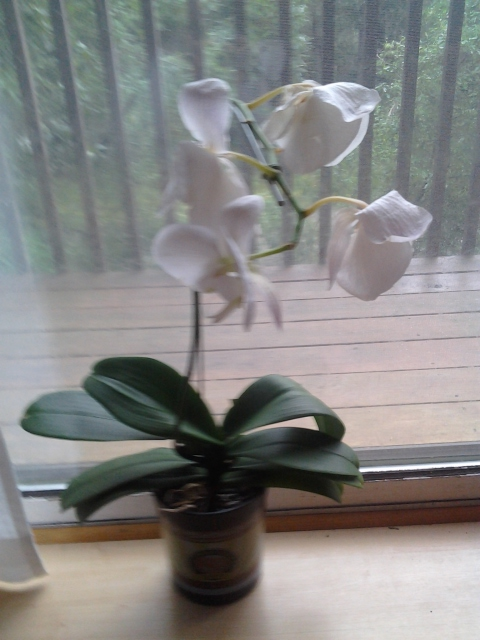Question Originalcondition
Originalcondition
 Currentcondition
Currentcondition
QUESTION: I have my first ever Orchid and I have no idea what I am doing. I found a few sites with well explained information (such as justaddiceorchids.com, howtodothings.com)but I am still lost. I do not know the type of Orchid, all I know is it appears to be salvageable. I live on a mountain and about an hour away from any towns or stores.
I read I ought to clean out the roots of my Orchid, remove any dead parts, and set in a bowl of water with a plastic bag around the whole thing. I do not have any miracle plant growth, but I read I could use epsom salt or white vinegar. I do not know if the Orchid I have is an "acid loving" plant so I do not know which of these substances to mix in the water.
Then I read I should put it into a new pot with fresh soil and water regularly but do not allow to sit in old water.
I am about to make a trip into town and could purchase any recomended tools for restoring this beautiful Orchid. Any advice or information would be lovely. If you know by the picture what type of Orchid I have that would be wonderful to know as well.
Thank you for your time!
-Amanda
ANSWER: Thanks for sending the pictures Amanda. You have a phalaenopsis orchid. A common name is "moth orchid". The plant in your picture is an excellent condition. Moth orchids can be grown under house plant conditions (ie best at 70-85 Degrees F.). They prefer the indirect light from an east window. However, because of the high variability in natural day length in your location you may need to use artificial lighting on a timer. In winter, set your timer on 13 hours of day length and gradually increase day length to 16 hours in summer. Phalaenopsis leaves that are dark green may not be receiving enough light to rebloom next spring so provide enough light so new leaf growth are a lighter green. I recommend that you cut off the old flower spike just above the second or third joint. Depending upon parentage, the remaining flower spike may branch at one of the remaining joints. Be careful not to overwater-- looks like your current watering practices are fine.
With regard to repotting, I recommend that you repot into a pot about inch larger in diameter to provide more room for future root growth.. To repot, you should use a commercially prepared orchid potting mix containing fir bark. Companies such a Better Grow sell this potting mix in hobby bags. Strain out the fine particles and dust prior to use. If the potting mix is dry, you will need to soak it thoroughly before use. In unpotting your plant, remove any roots that are mushy or stringy before repotting. To repot, rotate the pot as you lower the roots into the new pot. This will allow the roots to lie next to the pot walls minimizing root damage. Then add the orchid potting mix while tapping the pot to encourage settling of the potting mix amongst the roots..
No need to panic if you can't repot now. The purpose of repotting your plant is to continue to keep it in good condition.
---------- FOLLOW-UP ----------
QUESTION: Thank you for your response, the information is helpful and quite clear. Between initially writing you and today I have soaked the roots in water with a little hydrogen peroxide and then removed as much mold and dead looking parts as possible. I then placed into a plastic holder with drainage holes, and placed that into a larger pot with maybe 1/2 a centimeter of water in the bottom (the water not touching the roots. I added two drops of an essential oil "OnGuard" and "meleluca" which are antifungal and certified pure therapeutic grade essential oils. Then I wrapped a plastic bag around the whole thing. It looks better to me now, but I havent opened the plastic and checked the roots to see if there is re-growth of mold.
Do you feel that was a bad choice? Should I let it sit out and be dry until I can re pot it, or leave it without dirt/soil and just make sure it gets some water?
Thank you!
AnswerI think your approach is a good stop-gap until you can obtain the needed supplies. I'm not familiar with the use of essential oils on plants-- with the exception of Neem Oil which is now widely available for use on plant issues. By maintaining high humidity, this should prevent drying out, however, this can also promote mold growth. Continue your monitoring and, if you see continuing mold growth, it may be that essential oils are ineffective. It is possible to mail order all of your needed supplies from orchid dealers in the lower 48 states. If you decide to go that route, let me know and I can give you the names and addresses of a couple I use.







